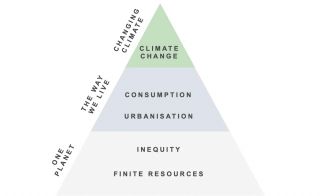
www.buildingsandcities.org/insights/commentaries/critical-turn-construction-management.html
The Need for a 'Critical Turn' in Construction Management Research

The drivers for construction management research are too narrow and need to be broadened. A more critical voice would be beneficial.
Roine Leiringer (University of Hong Kong) and Andy Dainty (Manchester Metropolitan University) find the recent B&C special issue, Modern Methods of Construction: Beyond Productivity Improvement, has a worthy (and much needed) aim of providing a critical approach to policy and practice.
Unfortunately, from what we have seen over the past 25 years, the kind of critical research work that Stuart Green calls for consistently fails to dislodge prevailing views and finds little traction within the construction management (CM) research community. Rather, it is often passed over as interesting and at best looked upon as a provocative counter discourse to the dominant orthodoxy, which drives so much scholarly enquiry. For most CM scholars, the prevailing modus operandi is to be responsive to industry demands, rather than questioning the underpinning assumptions upon which these demands are based. The road of least resistance, which is also the most immediately beneficial to the individual academic, is to follow whatever fads, fashions or policy improvement agendas are rolled out. Chasing 'relevance' in this way unfailingly improves the chances of attaining research funding and the support of key (usually large) construction firms. Yet, it also removes what we consider a crucial function of the construction management research field; that of being a critical voice of both policy and the activities of the sector, and an advocate for those who run counter to the instrumental rhetoric of 'big business'.
We agree with Green (2019; 2022): the implications of policy and orthodoxy, both intended and unintended, demand deeper scrutiny, especially when they privilege particular positions, technologies or organizations. Indeed, the processes through which industry recipes evolve and construction sector policy is produced rarely attracts critical attention. Nor does there tend to be any critical focus on whose interests are being served, and whose are being subjugated. Within this space, the allocated, and often self-imposed, role of the academic researcher tends to be forever limited to the provision of evidence in support of pre-determined policy and dominant industry narratives. Deviation from such a position is questioned and seldom openly supported.
What we have experienced both as authors and as long-term editors of a leading journal in the field is that papers that draw on critical approaches, and develop arguments that run counter to orthodoxy, tend to get a harsher treatment by referees. This aversion also shows through in the limited number of citations that 'critical' papers (not self-proclaimed critical reviews, which often are far from critical in the academic meaning of the word) tend to get. This is in stark contrast to the uptake of the abundance of 'critical success factor' papers, that commonly serve to enforce rather than challenge established practice. A similar argument can also be made for the chances of winning research funding. Our experience here is that proposals that seek to critically examine policy and associated policy instruments rarely are successful and it is in relative terms harder to get funded projects signed of at the end.
What we advocate is for more members of the CM community to actively challenge orthodoxy and to likewise encourage practitioners to reflect on their own actions and assumptions in order to better judge their impact and to consider other ways of thinking and acting. Through adopting a more critical approach, CM academics can play an important role in counterbalancing tendencies towards inertia and self-interest in organisations, as well as in industry more broadly. This is equally true in terms of criticism of policies and policymakers. Through offering critique of the factual assumptions on which policies are based, academics can make valuable contributions to both policy and the policy process. Value can also be derived from drawing attention to the assumptions relating to the consequences that are likely to follow from various actions and the likely effects on relevant agents. This would, if nothing else, help to foresee what Stuart Green refers to as 'unintended consequences'.
Within this 'critical turn', we see one of the roles of research as speaking for the marginalised, overlooked or silent majority who lack access to either the power structures or the discursive resources needed to shape and drive the debate. It is a truism that the interests of large firms dominate research funding (and perhaps also industry initiatives/reports), which makes such a countervailing discourse essential. Many industry-driven remedies of the past have been criticised for privileging the concerns and interests of large contractors and clients, highlighting a high degree of hegemony at play (cf. Fernie et al. 2006; Jensen et al. 2011; Dainty et al. 2017). Over time, the underlying structure of the industry, and its institutionalised practices, tend to remain largely intact, albeit it with the occasional change of guard among industry leaders (Green 2011). Thus, the incumbent (large) firms wield a large degree of power and have a disproportional influence over construction markets. The purposes and structure of the market are adapted to their interests, they get most of the valued objects (e.g. material and status rewards) and established rules also tend to favour them, and support their privileged position. Smaller firms (challengers) make up the majority of the market membership (for example, in Hong Kong >97% of construction firms are SMEs), but they occupy less privileged niches within the market and are seldom given a voice.
The history of construction innovation is strewn with failed, discarded and debunked technologies, managerialist interventions and attempts at automation, some of which are mentioned in Green (2022). Given these failures, explaining the recursive nature of such debates necessitates a broader understanding of the economics of the construction sector, which is also an argument presented by de Valence (2022) in his rejoinder to Green (2022). This is not the place for a full exploration of this debate, but in short, the reliance of the auction system in procurement leads to extremely low margins and drive particular firm behaviours aimed at delivering greater productivity and cost efficiencies. Within such a system one might expect the innovation to be omnipresent, but as Gruneberg (2023) points out, gains from innovation do little to affect the profit margins of contractors and developers in the long-term. Hence, while there may be a few large incumbent firms that can benefit from their position towards the head the value chain, those lower down are inevitably squeezed by the production imperative.
From a market perspective, modern methods of construction (MMC) entail approaches that, as Green (2022) notes, may have systemic consequences for the economic structure of the sector. MMC is, according to Green (2022), best understood on the basis of pre-manufactured value (PMV), which he defines as the proportion of offsite production as a percentage of the total measured work that goes into a building. In this perspective, MMC is tied into a long line of industrialization efforts that historically has been promoted in the construction sector, and arguably constitutes a radical alternative or counterstrategy to the fragmented and craft-based way of production. Platforms, as a subset of the MMC that have emerged in recent years, are in particular predicated on another economic logic than what characterizes the traditional neo-classical, transactional, economy in the construction sector.
Taking this argument a step further, rather than arguing for the perpetuation of this quest for productivity and cost efficiency epitomised by MMC, a turn towards the perspective of the small firm on such innovation might offer a counterweight to the technocratic incumbent-dominated discourse that the papers in this issue reveal. The rigidity of the system, whilst offering transparency and value to the customer, inevitably privileges the technologies espoused as panaceas by the elite. Anything getting in the way (from skills to firm size) are seen as inhibiters. Providing a voice for these marginalised perspectives is the essential corrective, but we see little evidence of this happening at scale within the CM research community.
It goes without saying that striving for change is not a bad thing and it would be very odd indeed if the public and private policy agenda did not push for the construction industry to 'do better'. Some of the associated initiatives might be novel, but most will invariably be a variation of a theme (cf. Fernie et al. 2006; Green 2011). Within this context, CM academics fill an important role in developing new, or improving on established, techniques and methods and in this way supporting industry. However, every once in a while there is a need to pause and critically reflect on who the ultimate beneficiaries of research are supposed to be, and who are denied any advantage gleaned.
We would argue very strongly that in the rapid and unpredictable development we are currently experiencing in the construction sector many of the dominant (traditional) approaches to research lack explanatory power and provide little insight into how people and institutions might change. An uncritical vision for future research is to plough ahead, solving immediate problems as set out in policy and industry agendas, and developing ever more elaborate tools to help the construction industry with short-term solutions. A more creative, and academically relevant, vision for research is one that breaks with the common sense assumptions of policy makers, senior management and trades people, in order to look at the world through a different lens and provides professional communities with new insights. This is what research at its best can and should provide.
References
Dainty, A., Leiringer, R., Fernie, S. and Harty, C. (2017). BIM and the small construction firm: a critical perspective. Building Research & Information, 45(6), 696-709.
de Valence, G. (2022). Situating MMC within Technological Adoption [Commentary]. Buildings & Cities. https://www.buildingsandcities.org/insights/commentaries/situating-mmc.html
Fernie, S., Leiringer, R. and Thorpe, T. (2006). Change in construction: a critical perspective. Building Research & Information, 34(2), 91-103.
Green, S.D. (2011). Making sense of construction improvement. Oxford: Wiley-Blackwell.
Green, S. D. (2019). Modern methods of construction: unintended consequences. [Commentary]. Buildings & Cities. https://www.buildingsandcities.org/insights/commentaries/modern-methods-of-construction.html
Green, S.D. (2022). Modern methods of construction: reflections on the current research agenda. Buildings & Cities, 3(1), 653-662. http://doi.org/10.5334/bc.265
Gruneberg, S. (2023). Construction Economics - it ain't what it used to be. In R. Leiringer & A. Dainty (eds): A research agenda for construction management. Cheltenham: Edward Elgar Publishing. (forthcoming)
Jensen, J.S., Gottlieb, S.C. and Thuesen, C.L. (2011). Construction sector development: frames and governance responses. Building Research & Information, 39(6), 665-677.
Latest Peer-Reviewed Journal Content
Acceptability of sufficiency consumption policies by Finnish households
E Nuorivaara & S Ahvenharju
Key factors for revitalising heritage buildings through adaptive reuse
É Savoie, J P Sapinski & A-M Laroche
Cooler streets for a cycleable city: assessing policy alignment
C Tang & J Bush
Understanding the embodied carbon credentials of modern methods of construction
R O'Hegarty, A McCarthy, J O'Hagan, T Thanapornpakornsin, S Raffoul & O Kinnane
The changing typology of urban apartment buildings in Aurinkolahti
S Meriläinen & A Tervo
Embodied climate impacts in urban development: a neighbourhood case study
S Sjökvist, N Francart, M Balouktsi & H Birgisdottir
Environmental effects of urban wind energy harvesting: a review
I Tsionas, M laguno-Munitxa & A Stephan
Office environment and employee differences by company health management certification
S Arata, M Sugiuchi, T Ikaga, Y Shiraishi, T Hayashi, S Ando & S Kawakubo
Spatiotemporal evaluation of embodied carbon in urban residential development
I Talvitie, A Amiri & S Junnila
Energy sufficiency in buildings and cities: current research, future directions [editorial]
M Sahakian, T Fawcett & S Darby
Sufficiency, consumption patterns and limits: a survey of French households
J Bouillet & C Grandclément
Health inequalities and indoor environments: research challenges and priorities [editorial]
M Ucci & A Mavrogianni
Operationalising energy sufficiency for low-carbon built environments in urbanising India
A B Lall & G Sethi
Promoting practices of sufficiency: reprogramming resource-intensive material arrangements
T H Christensen, L K Aagaard, A K Juvik, C Samson & K Gram-Hanssen
Culture change in the UK construction industry: an anthropological perspective
I Tellam
Are people willing to share living space? Household preferences in Finland
E Ruokamo, E Kylkilahti, M Lettenmeier & A Toppinen
Towards urban LCA: examining densification alternatives for a residential neighbourhood
M Moisio, E Salmio, T Kaasalainen, S Huuhka, A Räsänen, J Lahdensivu, M Leppänen & P Kuula
A population-level framework to estimate unequal exposure to indoor heat and air pollution
R Cole, C H Simpson, L Ferguson, P Symonds, J Taylor, C Heaviside, P Murage, H L Macintyre, S Hajat, A Mavrogianni & M Davies
Finnish glazed balconies: residents' experience, wellbeing and use
L Jegard, R Castaño-Rosa, S Kilpeläinen & S Pelsmakers
Modelling Nigerian residential dwellings: bottom-up approach and scenario analysis
C C Nwagwu, S Akin & E G Hertwich
Mapping municipal land policies: applications of flexible zoning for densification
V Götze, J-D Gerber & M Jehling
Energy sufficiency and recognition justice: a study of household consumption
A Guilbert
Linking housing, socio-demographic, environmental and mental health data at scale
P Symonds, C H Simpson, G Petrou, L Ferguson, A Mavrogianni & M Davies
Measuring health inequities due to housing characteristics
K Govertsen & M Kane
Provide or prevent? Exploring sufficiency imaginaries within Danish systems of provision
L K Aagaard & T H Christensen
Imagining sufficiency through collective changes as satisfiers
O Moynat & M Sahakian
US urban land-use reform: a strategy for energy sufficiency
Z M Subin, J Lombardi, R Muralidharan, J Korn, J Malik, T Pullen, M Wei & T Hong
Mapping supply chains for energy retrofit
F Wade & Y Han
Operationalising building-related energy sufficiency measures in SMEs
I Fouiteh, J D Cabrera Santelices, A Susini & M K Patel
Promoting neighbourhood sharing: infrastructures of convenience and community
A Huber, H Heinrichs & M Jaeger-Erben
New insights into thermal comfort sufficiency in dwellings
G van Moeseke, D de Grave, A Anciaux, J Sobczak & G Wallenborn
'Rightsize': a housing design game for spatial and energy sufficiency
P Graham, P Nourian, E Warwick & M Gath-Morad
Implementing housing policies for a sufficient lifestyle
M Bagheri, L Roth, L Siebke, C Rohde & H-J Linke
The jobs of climate adaptation
T Denham, L Rickards & O Ajulo
Structural barriers to sufficiency: the contribution of research on elites
M Koch, K Emilsson, J Lee & H Johansson
Disrupting the imaginaries of urban action to deliver just adaptation [editorial]
V Castán-Broto, M Olazabal & G Ziervogel
Nature for resilience reconfigured: global- to-local translation of frames in Africa
K Rochell, H Bulkeley & H Runhaar
How hegemonic discourses of sustainability influence urban climate action
V Castán Broto, L Westman & P Huang
Fabric first: is it still the right approach?
N Eyre, T Fawcett, M Topouzi, G Killip, T Oreszczyn, K Jenkinson & J Rosenow
Social value of the built environment [editorial]
F Samuel & K Watson
Understanding demolition [editorial]
S Huuhka
Data politics in the built environment [editorial]
A Karvonen & T Hargreaves



Latest Commentaries
Decolonising Cities: The Role of Street Naming
During colonialisation, street names were drawn from historical and societal contexts of the colonisers. Street nomenclature deployed by colonial administrators has a role in legitimising historical narratives and decentring local languages, cultures and heritage. Buyana Kareem examines street renaming as an important element of decolonisation.
Integrating Nature into Cities
Increasing vegetation and green and blue spaces in cities can support both climate change mitigation and adaptation goals, while also enhancing biodiversity and ecological health. Maibritt Pedersen Zari (Auckland University of Technology) explains why nature-based solutions (NbS) must be a vital part of urban planning and design.